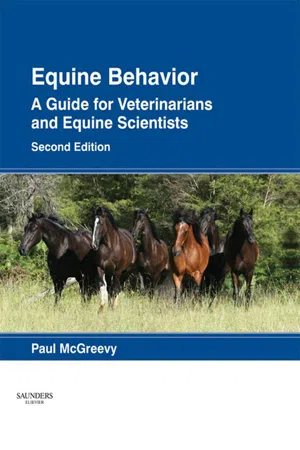
- 368 pages
- English
- ePUB (mobile friendly)
- Available on iOS & Android
About this book
Equine Behavior: A guide for Veterinarians and Equine Scientists is the quintessential reference for all who really want to know what makes horses tick.Research in horse behavior has made great strides in recent years. This book examines the truth behind modern trends and ancient traditions. Full of insight, it rounds up the latest findings of practitioners and researchers from all over the world, drawing on both cutting-edge research and best practice. With more than 1, 000 references, the book explores equine behavior from first principles, by considering the behavior of free-ranging horses and focusing on ways in which management and training influence the responses of their domestic counterparts. Equine physicians, trainers, handlers and owners all need to be students of equine behavior, because the first sign of a problem is often a change in behavior. So, whether you own, ride, lead, groom, feed or heal horses, what you observe is vital to your understanding.Behavioral problems in the stable and under saddle are a grave concern for equine veterinarians worldwide, because they can lead to poor performance, welfare issues, abuse and, ultimately, wastage. Traditionally, veterinarians gave priority to the physical health of their equine patients. This book is a unique attempt to demonstrate the way science can throw light on how and why problems and unwelcome behaviors arise. It also offers ways to bring about change for the better.Beautifully illustrated with more than 500 photographs and line diagrams, Equine Behavior: A guide for veterinarians and equine scientists is an essential resource for practising veterinarians, students and enthusiasts with a specific interest in horses, ponies, and donkeys. Professional trainers and handlers, equine scientists and behavior therapists will also find its contents invaluable.Paul McGreevy is Senior Lecturer in Animal Behavior at the University of Sydney's Faculty of Veterinary Science
- Features a practical, hands-on approach to all aspects of equine behavior
- Discusses all factors that effect equine behavior
- Contrasts normal behavior with abnormal behavior
- Reviews all behavioral problems
- Lists and reviews the latest drug therapies
- Addresses difficult-to-treat clinical problems such as head-shaking, with insights from the leading researcher in this area
- Provides a brief clinical evaluation of 'horse-whispering'
- Illustrates the key behavioral differences between horses and donkeys
Frequently asked questions
- Essential is ideal for learners and professionals who enjoy exploring a wide range of subjects. Access the Essential Library with 800,000+ trusted titles and best-sellers across business, personal growth, and the humanities. Includes unlimited reading time and Standard Read Aloud voice.
- Complete: Perfect for advanced learners and researchers needing full, unrestricted access. Unlock 1.4M+ books across hundreds of subjects, including academic and specialized titles. The Complete Plan also includes advanced features like Premium Read Aloud and Research Assistant.
Please note we cannot support devices running on iOS 13 and Android 7 or earlier. Learn more about using the app.
Information
Evolution and classification

Evolutionary background
Classification of equids
Equus caballus and Equus przewalskii
| Common name | Species | Diploid chromosome number |
|---|---|---|
| Przewalski’s horse ([Mongolian] wild horse) | Equus przewalskii | 66 |
| Horse (domestic) | Equus caballus | 64 |
| African wild ass (and domestic donkey) | Equus asinus | 62 |
| Nubian wild ass | Equus asinus africanus | |
| Somali wild Ass | Equus asinus somalicus | |
| Asian ass | Equus hemionus | 56 |
| Mongolian wild ass | Equus hemionus hemionus | |
| Onager | Equus hemionus onager | |
| Indian wild ass | Equus hemionus khur | |
| Kiang | Equus hemionus kiang | |
| Grevy’s zebra | Equus grevyi | 46 |
| Common zebra | Equus burchelli | 44 |
| Chapman’s zebra | Equus burchelli antiquorum | |
| Grant’s zebra | Equus burchelli boehmi | |
| Selous’s zebra | Equus burchelli selousi | |
| Mountain z... |
Table of contents
- Cover image
- Title page
- Table of Contents
- Dedication
- Copyright
- Guest contributors
- Preface
- Acknowledgments
- Chapter 1: Introduction
- Chapter 2: Perception
- Chapter 3: Behavior and the brain
- Chapter 4: Learning
- Chapter 5: Social behavior
- Chapter 6: Communication
- Chapter 7: Locomotory behavior
- Chapter 8: Ingestive behavior
- Chapter 9: Eliminative behavior
- Chapter 10: Body care
- Chapter 11: Behavior of the stallion
- Chapter 12: Behavior of the mare
- Chapter 13: Equitation science
- Chapter 14: Handling and transport
- Chapter 15: Miscellaneous unwelcome behaviors, their causes and resolution
- Further reading
- Glossary of colloquialisms, ethological and equestrian terms
- Index